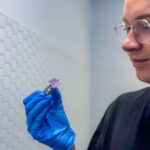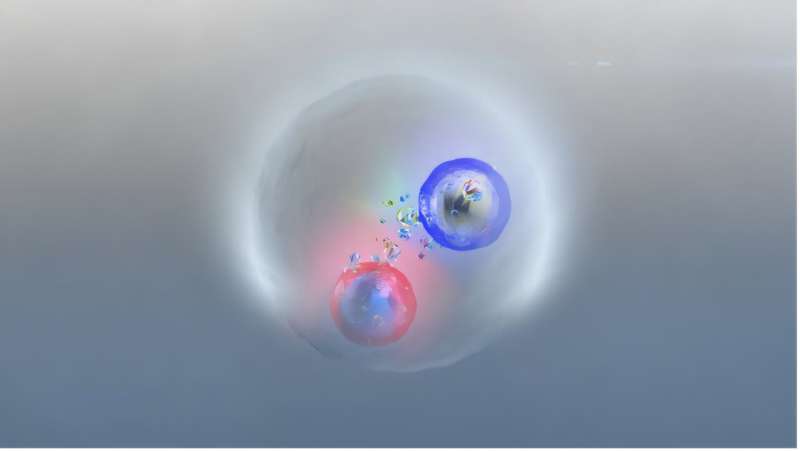An unexpected feature in proton-proton collisions, first observed by the CMS experiment at CERN’s Large Hadron Collider (LHC), has been confirmed by the ATLAS experiment. This discovery, announced at the European Physical Society’s High-Energy Physics conference in Marseille, suggests that top quarks—the heaviest and shortest-lived elementary particles—can form a transient “quasi-bound-state” known as toponium with their antimatter counterparts.
The confirmation of this phenomenon is a significant milestone in particle physics. It opens new avenues for understanding the strong nuclear force, or quantum chromodynamics (QCD), which governs the interactions of quarks and gluons. High-energy collisions at the LHC routinely produce top quark-antiquark pairs, and measuring the probability of this process serves as a crucial test of the Standard Model of particle physics.
Discovery and Implications
Last year, researchers from the CMS experiment noticed an unusual surplus of top quark-antiquark pairs while analyzing data from 2016 to 2018. This surplus, appearing at the minimum energy required to produce such pairs, hinted at the possible formation of toponium—a concept previously deemed too elusive to detect at the LHC.
The top quark, unlike other quarks, typically does not form bound states due to its fleeting existence. However, quantum mechanics allows for the occasional survival of a top quark-antiquark pair long enough to exchange gluons, creating the toponium state. The CMS experiment measured the cross section for this excess at 8.8 picobarns (pb) with an uncertainty of 1.3 pb, surpassing the “five sigma” threshold required for a discovery in particle physics.
“The observation of a non-relativistic QCD effect that was thought to be too difficult to detect is a great triumph for the LHC experiment program,” said CMS spokesperson Gautier Hamel de Monchenault.
ATLAS Experiment Confirmation
The ATLAS collaboration, examining the complete LHC Run-2 dataset from 2015 to 2018, has also observed this effect. Their data rejects models that ignore the formation of a quasi-bound-state with a significance of 7.7 sigma, determining the production cross section of the excess to be 9.0±1.3 pb, closely aligning with CMS findings.
The presence of this unforeseen phenomenon in LHC data presents a challenge: confirming its underlying cause. An alternative hypothesis suggests the existence of a new particle, with a mass near twice that of the top quark, produced in gluon collisions and decaying into a top quark-antiquark pair.
“For a long time, it was considered experimentally unfeasible to measure this subtle effect at the LHC,” said ATLAS spokesperson Stéphane Willocq. “Thanks to the wealth of proton-proton data recorded during Run 2 and advances in analysis techniques, this assumption is now being overturned.”
Broader Impact and Future Research
If the toponium hypothesis is confirmed, it would add a new chapter to the study of quarkonia—unstable states formed from heavy quark-antiquark pairings. The discovery of charmonium in 1974 and bottomonium three years later marked significant milestones in particle physics, sparking the “November Revolution” in the field.
CERN’s Director of Research and Computing, Joachim Mnich, emphasized the importance of these findings:
“These impressive results from ATLAS and CMS prove that there is still much to learn about the Standard Model of Particle Physics at high energies. They show that high-precision measurements can reveal remarkably subtle phenomena that deepen our understanding of nature.”
With the ongoing Run 3 of the LHC expected to yield significantly more data, the ATLAS and CMS collaborations are poised to further explore the strong force through top quark-antiquark interactions in the non-relativistic regime. This research has been accepted for publication in Reports on Progress in Physics, promising to contribute valuable insights into the fundamental forces of nature.
 Breakthrough in Quantum Battery Technology Extends Lifespan 1,000-Fold
Breakthrough in Quantum Battery Technology Extends Lifespan 1,000-Fold Yulia Putintseva Requests Spectator Removal at Wimbledon Over Safety Concerns
Yulia Putintseva Requests Spectator Removal at Wimbledon Over Safety Concerns Exploring Canadian Cuisine: A Culinary Journey Across a Diverse Nation
Exploring Canadian Cuisine: A Culinary Journey Across a Diverse Nation STEM Immigration: Shaping Diversity in the U.S. Workforce
STEM Immigration: Shaping Diversity in the U.S. Workforce How to Observe July’s Brightest Planets: A Stargazer’s Guide
How to Observe July’s Brightest Planets: A Stargazer’s Guide